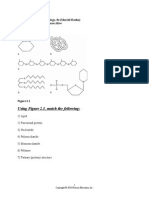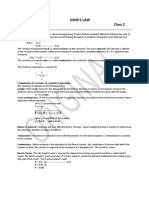Vsepr Theory
Vsepr Theory
Uploaded by
Aziz AhmadCopyright:
Available Formats
Vsepr Theory
Vsepr Theory
Uploaded by
Aziz AhmadOriginal Description:
Copyright
Available Formats
Share this document
Did you find this document useful?
Is this content inappropriate?
Copyright:
Available Formats
Vsepr Theory
Vsepr Theory
Uploaded by
Aziz AhmadCopyright:
Available Formats
Inorganic Chemistry/Chemical Bonding/VSEPR theory
Inorganic Chemistry/Chemical Bonding/VSEPR
theory
Valence shell electron pair repulsion (VSEPR) theory (1957) is a model in chemistry, which is used for predicting
the shapes of individual molecules, based upon their extent of electron-pair electrostatic repulsion, determined using
steric numbers[1] . The theory is also called the Gillespie-Nyholm theory after the two main developers. The
premise of VSEPR is that a constructed Lewis structure is expanded to show all lone pairs of electrons alongside
protruding and projecting bonds, for predicting the geometric shape and lone-pair behavior of a compound through
consideration of the total coordination number.
VSEPR theory is based on the idea that the geometry of a molecule or polyatomic ion is determined primarily by
repulsion among the pairs of electrons associated with a central atom. The pairs of electrons may be bonding or
nonbonding (also called lone pairs). Only valence electrons of the central atom influence the molecular shape in a
meaningful way.
Basic assumptions
1. Pairs of electrons in the valence shell of a central atom repel each other.
2. These pairs of electrons tend to occupy positions in space that minimize repulsions and maximize the distance of
separation between them.
3. The valence shell is taken as a sphere with electron pairs localizing on the spherical surface at maximum distance
from one another.
4. A multiple bond is treated as if it is a single electron pair and the two or three electron pairs of a multiple bond
are treated as a single super pair.
5. Where two or more resonance structures can depict a molecule the VSEPR model is applicable to any such
structure.
Three types of repulsion take place between the electrons of a molecule:
The lone pair-lone pair repulsion
The lone pair-bonding pair repulsion
The bonding pair-bonding pair repulsion.
A molecule must avoid these repulsions to remain stable. When repulsion cannot be avoided, the weaker repulsion
(i.e. the one that causes the smallest deviation from the ideal shape) is preferred.
The lone pair-lone pair (lp-lp) repulsion is considered to be stronger than the lone pair-bonding pair (lp-bp)
repulsion, which in turn is stronger than the bonding pair-bonding pair (bp-bp) repulsion. Hence, the weaker bp-bp
repulsion is preferred over the lp-lp or lp-bp repulsion.
VSEPR theory is usually compared (but not part of) and contrasted with valence bond theory, which addresses
molecular shape through orbitals that are energetically accessible for bonding. Valence bond theory concerns itself
with the formation of sigma and pi bonds. Molecular orbital theory is another model for understanding how atoms
and electrons are assembled into molecules and polyatomic ions.
VSEPR theory has long been criticized for not being quantitative, and therefore limited to the generation of "crude",
even though structurally accurate, molecular geometries of covalent molecules. However, molecular mechanics force
fields based on VSEPR have also been developed.[2]
Inorganic Chemistry/Chemical Bonding/VSEPR theory
AXE Method
The "AXE method" of electron counting is commonly used when applying the VSEPR theory. The A represents the
central atom and always has an implied subscript one. The X represents how many sigma bonds are formed between
the central atoms and outside atoms. Multiple covalent bonds (double, triple, etc) count as one X. The E represents
the number of lone electron pairs present outside of the central atom. The sum of X and E, sometimes known as the
steric number, is also associated with the total number of hybridised orbitals used by valence bond theory.
Steric
No.
Basic Geometry
0 lone pair
1 lone pair
2 lone pairs
3 lone pairs
1
linear
2
linear
Linear
Trigonal Planar
trigonal planar
bent
4
tetrahedral
trigonal pyramid
bent
linear
trigonal bipyramid
seesaw (chemistry) T-shaped (chemistry)
octahedral
square pyramid
Pentagonal bipyramid
pentagonal pyramid
square planar
linear
Inorganic Chemistry/Chemical Bonding/VSEPR theory
Type
Shape
AX1E*
Diatomic
HF, O2
AX2E0
Linear
BeCl2, HgCl2, CO2
AX2E1
Bent
NO2, SO2, O3
AX2E2
Bent
H2O, OF2
AX2E3
Linear
XeF2, I3
AX3E0
Trigonal planar
BF3, CO32, NO3, SO3
AX3E1
Trigonal pyramidal
NH3, PCl3
AX3E2
T-shaped
ClF3, BrF3
AX4E0
Tetrahedral
CH4, PO43, SO42, ClO4
AX4E1
Seesaw
SF4
AX4E2
Square Planar
XeF4
AX5E0
Trigonal Bipyramidal
PCl5
AX5E1
Square Pyramidal
ClF5, BrF5
AX6E0
Octahedral
SF6
AX6E1
Pentagonal pyramidal
XeF6
Geometry
Geometry
Examples
Inorganic Chemistry/Chemical Bonding/VSEPR theory
AX7E0 Pentagonal bipyramidal
4
IF7
Geometry including lone pairs, shown in pale yellow
Geometry excluding lone pairs
When the substituent (X) atoms are not all the same, the geometry is still approxmiately valid, but the bond angles
may be slightly different than the ones where all the outside atoms are the same. For example, the double-bond
carbons in alkenes like C2H4 are AX3E0, but the bond angles are not all exactly 120 . Similarly, SOCl2 is AX3E1,
but because the X substituents are not identical, the XAX angles are not all equal.
Examples
The methane molecule (CH4) is tetrahedral because there are four pairs of electrons. The four hydrogen atoms are
positioned at the vertices of a tetrahedron, and the bond angle is cos-1(-1/3) 10928'. This is referred to as an AX4
type of molecule. As mentioned above, A represents the central atom and X represents all of the outer atoms.
The ammonia molecule (NH3) has three pairs of electrons involved in bonding, but there is a lone pair of electrons
on the nitrogen atom. It is not bonded with another atom; however, it influences the overall shape through repulsions.
As in methane above, there are four regions of electron density. Therefore, the overall orientation of the regions of
electron density is tetrahedral. On the other hand, there are only three outer atoms. This is referred to as an AX3E
type molecule because the lone pair is represented by an E. The overall shape of the molecule is a trigonal pyramid
because the lone pair is not "visible." The shape of a molecule is found from the relationship of the atoms even
though it can be influenced by lone pairs of electrons.
A steric number of seven is possible, but it occurs in uncommon compounds such as iodine heptafluoride. The base
geometry for this is pentagonal bipyramidal.
References
[1] Modern Inorganic Chemistry W.L. Jolly ISBN 0-07-032760-2
[2] VGS Box. Journal of Molecular Modeling, 1997, 3, 124-141.
Article Sources and Contributors
Article Sources and Contributors
Inorganic Chemistry/Chemical Bonding/VSEPR theory Source: http://en.wikibooks.org/w/index.php?oldid=1575530 Contributors: Adrignola, Aitias, Bandaruvamsi1991, Bduke, Captain
Video, Charles Matthews, CommonsDelinker, Dannown, DavidRKelly, Dirac66, HappyCamper, Hugo-cs, Hyenaste, Itub, Jag123, Jokermole, Joris Gillis, Keimzelle, Kigoe, Kinglz, Kkyman,
Leif edling, LittleOldMe, M1ss1ontomars2k4, Matthias M., Maurreen, Mike.lifeguard, Minestrone Soup, Neutrality, Ohwell32, Oxymoron83, PB54, Physchim62, Pmccord, Ram einstein,
Rappinelvis, Razsafi, Rganand, Richard001, Rune.welsh, Sareen eng, Science man, Shanes, Spoon!, StuffOfInterest, The Valid One, Thewinster, Truelight, V8rik, Vkmaxwell, Vsmith, Wafulz,
Xebvor, 65 anonymous edits
Image Sources, Licenses and Contributors
Image:AX1E0-2D.png Source: http://en.wikibooks.org/w/index.php?title=File:AX1E0-2D.png License: Public Domain Contributors: Benjah-bmm27
Image:AX2E0-2D.png Source: http://en.wikibooks.org/w/index.php?title=File:AX2E0-2D.png License: Public Domain Contributors: Benjah-bmm27
Image:AX1E1-2D.png Source: http://en.wikibooks.org/w/index.php?title=File:AX1E1-2D.png License: Public Domain Contributors: Benjah-bmm27
Image:AX3E0-side-2D.png Source: http://en.wikibooks.org/w/index.php?title=File:AX3E0-side-2D.png License: Public Domain Contributors: Benjah-bmm27
Image:AX2E1-2D.png Source: http://en.wikibooks.org/w/index.php?title=File:AX2E1-2D.png License: Public Domain Contributors: Benjah-bmm27
Image:AX1E2-2D.png Source: http://en.wikibooks.org/w/index.php?title=File:AX1E2-2D.png License: Public Domain Contributors: Benjah-bmm27
Image:AX4E0-2D.png Source: http://en.wikibooks.org/w/index.php?title=File:AX4E0-2D.png License: Public Domain Contributors: Benjah-bmm27
Image:AX3E1-2D.png Source: http://en.wikibooks.org/w/index.php?title=File:AX3E1-2D.png License: Public Domain Contributors: Benjah-bmm27
Image:AX2E2-2D.png Source: http://en.wikibooks.org/w/index.php?title=File:AX2E2-2D.png License: Public Domain Contributors: Benjah-bmm27
Image:AX1E3-2D.png Source: http://en.wikibooks.org/w/index.php?title=File:AX1E3-2D.png License: Public Domain Contributors: Benjah-bmm27
Image:AX5E0-2D.png Source: http://en.wikibooks.org/w/index.php?title=File:AX5E0-2D.png License: Public Domain Contributors: Benjah-bmm27
Image:AX4E1-2D.png Source: http://en.wikibooks.org/w/index.php?title=File:AX4E1-2D.png License: Public Domain Contributors: Benjah-bmm27
Image:AX3E2-2D.png Source: http://en.wikibooks.org/w/index.php?title=File:AX3E2-2D.png License: Public Domain Contributors: Benjah-bmm27
Image:AX2E3-2D.png Source: http://en.wikibooks.org/w/index.php?title=File:AX2E3-2D.png License: Public Domain Contributors: Benjah-bmm27
Image:AX6E0-2D.png Source: http://en.wikibooks.org/w/index.php?title=File:AX6E0-2D.png License: Public Domain Contributors: Benjah-bmm27
Image:AX5E1-2D.png Source: http://en.wikibooks.org/w/index.php?title=File:AX5E1-2D.png License: Public Domain Contributors: Benjah-bmm27
Image:AX4E2-2D.png Source: http://en.wikibooks.org/w/index.php?title=File:AX4E2-2D.png License: Public Domain Contributors: Benjah-bmm27
Image:AX7E0-2D.png Source: http://en.wikibooks.org/w/index.php?title=File:AX7E0-2D.png License: Public Domain Contributors: Benjah-bmm27
Image:AX6E1-2D.png Source: http://en.wikibooks.org/w/index.php?title=File:AX6E1-2D.png License: Public Domain Contributors: Benjah-bmm27
Image:AX1E0-3D-balls.png Source: http://en.wikibooks.org/w/index.php?title=File:AX1E0-3D-balls.png License: Public Domain Contributors: Benjah-bmm27
Image:AX2E0-3D-balls.png Source: http://en.wikibooks.org/w/index.php?title=File:AX2E0-3D-balls.png License: Public Domain Contributors: Benjah-bmm27
Image:Linear-3D-balls.png Source: http://en.wikibooks.org/w/index.php?title=File:Linear-3D-balls.png License: Public Domain Contributors: Benjah-bmm27
Image:AX2E1-3D-balls.png Source: http://en.wikibooks.org/w/index.php?title=File:AX2E1-3D-balls.png License: Public Domain Contributors: Benjah-bmm27
Image:Bent-3D-balls.png Source: http://en.wikibooks.org/w/index.php?title=File:Bent-3D-balls.png License: Public Domain Contributors: Benjah-bmm27
Image:AX2E2-3D-balls.png Source: http://en.wikibooks.org/w/index.php?title=File:AX2E2-3D-balls.png License: Public Domain Contributors: Benjah-bmm27
Image:AX2E3-3D-balls.png Source: http://en.wikibooks.org/w/index.php?title=File:AX2E3-3D-balls.png License: Public Domain Contributors: Benjah-bmm27
Image:AX3E0-3D-balls.png Source: http://en.wikibooks.org/w/index.php?title=File:AX3E0-3D-balls.png License: Public Domain Contributors: Benjah-bmm27
Image:Trigonal-3D-balls.png Source: http://en.wikibooks.org/w/index.php?title=File:Trigonal-3D-balls.png License: Public Domain Contributors: Benjah-bmm27
Image:AX3E1-3D-balls.png Source: http://en.wikibooks.org/w/index.php?title=File:AX3E1-3D-balls.png License: Public Domain Contributors: Benjah-bmm27
Image:Pyramidal-3D-balls.png Source: http://en.wikibooks.org/w/index.php?title=File:Pyramidal-3D-balls.png License: Public Domain Contributors: Benjah-bmm27
Image:AX3E2-3D-balls.png Source: http://en.wikibooks.org/w/index.php?title=File:AX3E2-3D-balls.png License: Public Domain Contributors: Benjah-bmm27
Image:T-shaped-3D-balls.png Source: http://en.wikibooks.org/w/index.php?title=File:T-shaped-3D-balls.png License: Public Domain Contributors: Benjah-bmm27
Image:AX4E0-3D-balls.png Source: http://en.wikibooks.org/w/index.php?title=File:AX4E0-3D-balls.png License: Public Domain Contributors: Benjah-bmm27
Image:Tetrahedral-3D-balls.png Source: http://en.wikibooks.org/w/index.php?title=File:Tetrahedral-3D-balls.png License: Public Domain Contributors: Benjah-bmm27
Image:AX4E1-3D-balls.png Source: http://en.wikibooks.org/w/index.php?title=File:AX4E1-3D-balls.png License: Public Domain Contributors: Benjah-bmm27
Image:Seesaw-3D-balls.png Source: http://en.wikibooks.org/w/index.php?title=File:Seesaw-3D-balls.png License: Public Domain Contributors: Benjah-bmm27
Image:AX4E2-3D-balls.png Source: http://en.wikibooks.org/w/index.php?title=File:AX4E2-3D-balls.png License: Public Domain Contributors: Benjah-bmm27
Image:Square-planar-3D-balls.png Source: http://en.wikibooks.org/w/index.php?title=File:Square-planar-3D-balls.png License: Public Domain Contributors: Benjah-bmm27, Zzyzx11
Image:Trigonal-bipyramidal-3D-balls.png Source: http://en.wikibooks.org/w/index.php?title=File:Trigonal-bipyramidal-3D-balls.png License: Public Domain Contributors: Benjah-bmm27
Image:AX5E1-3D-balls.png Source: http://en.wikibooks.org/w/index.php?title=File:AX5E1-3D-balls.png License: Public Domain Contributors: Benjah-bmm27
Image:Square-pyramidal-3D-balls.png Source: http://en.wikibooks.org/w/index.php?title=File:Square-pyramidal-3D-balls.png License: Public Domain Contributors: Benjah-bmm27
Image:AX6E0-3D-balls.png Source: http://en.wikibooks.org/w/index.php?title=File:AX6E0-3D-balls.png License: Public Domain Contributors: Benjah-bmm27
Image:Octahedral-3D-balls.png Source: http://en.wikibooks.org/w/index.php?title=File:Octahedral-3D-balls.png License: Public Domain Contributors: Benjah-bmm27
Image:AX6E1-3D-balls.png Source: http://en.wikibooks.org/w/index.php?title=File:AX6E1-3D-balls.png License: Public Domain Contributors: Benjah-bmm27
Image:Pentagonal-pyramidal-3D-balls.png Source: http://en.wikibooks.org/w/index.php?title=File:Pentagonal-pyramidal-3D-balls.png License: Public Domain Contributors: Benjah-bmm27
Image:AX7E0-3D-balls.png Source: http://en.wikibooks.org/w/index.php?title=File:AX7E0-3D-balls.png License: Public Domain Contributors: Benjah-bmm27
Image:Pentagonal-bipyramidal-3D-balls.png Source: http://en.wikibooks.org/w/index.php?title=File:Pentagonal-bipyramidal-3D-balls.png License: Public Domain Contributors:
Benjah-bmm27
License
Creative Commons Attribution-Share Alike 3.0 Unported
http:/ / creativecommons. org/ licenses/ by-sa/ 3. 0/
You might also like
- Kelvin Equation - A ReviewDocument12 pagesKelvin Equation - A ReviewKonkmanNo ratings yet
- Chapter - 7 Slides - General Chemistry - Open StaxDocument96 pagesChapter - 7 Slides - General Chemistry - Open Staxonline purchaseNo ratings yet
- CH 02 Practice TestDocument16 pagesCH 02 Practice TestTheodore LiwonganNo ratings yet
- Arduino Uno CNC ShieldDocument11 pagesArduino Uno CNC ShieldMărian IoanNo ratings yet
- Study and Analysis of Atomic SpectraDocument10 pagesStudy and Analysis of Atomic Spectraabhijeet100% (1)
- Interatomic Forces: What Kind of Force Holds The Atoms Together in A Solid?Document36 pagesInteratomic Forces: What Kind of Force Holds The Atoms Together in A Solid?aditya_2013No ratings yet
- Lecture 02/unit II (Chemical Bonding) VSEPR TheoryDocument4 pagesLecture 02/unit II (Chemical Bonding) VSEPR TheorySkyblueNo ratings yet
- MELC 7 Chemical Bonding 1Document32 pagesMELC 7 Chemical Bonding 1A Dee YoungNo ratings yet
- PolarizabilityDocument8 pagesPolarizabilitygone4328No ratings yet
- UV Visible SpectrosDocument8 pagesUV Visible Spectrosbarani_autNo ratings yet
- Magnetism in SolidsDocument11 pagesMagnetism in SolidsNeelam KapoorNo ratings yet
- 2.1 The Structure of SolidsDocument22 pages2.1 The Structure of Solidsashleykingpalomo13No ratings yet
- Band Theory of SolidsDocument18 pagesBand Theory of SolidsSachi SinghNo ratings yet
- Introduction To Lattice EnergyDocument16 pagesIntroduction To Lattice EnergyRohan AhmedNo ratings yet
- Chemical Bonding and Molecular StructureDocument6 pagesChemical Bonding and Molecular StructureSahil BhardwajNo ratings yet
- Solid State Chemistry - EPMDocument8 pagesSolid State Chemistry - EPMjahidul islamNo ratings yet
- 3 PotentiometryDocument11 pages3 Potentiometry175-44-Faraz HussainNo ratings yet
- Electrodes and PotentiometryDocument26 pagesElectrodes and PotentiometryMegha AnandNo ratings yet
- APPLIED PHYSICS Bonding in Solids by CHARIS ISRAEL ANCHADocument17 pagesAPPLIED PHYSICS Bonding in Solids by CHARIS ISRAEL ANCHACharis Israel Ancha100% (1)
- Atomic Spectrum HydrogenDocument7 pagesAtomic Spectrum Hydrogenaparajit5054No ratings yet
- Models of Molecular Compounds Lab (Ms. Possible)Document5 pagesModels of Molecular Compounds Lab (Ms. Possible)Steven GomescoelloNo ratings yet
- Molecular Orbital TheoryDocument28 pagesMolecular Orbital TheoryYen Yen YapNo ratings yet
- Lattice EnergyDocument8 pagesLattice Energy观龙No ratings yet
- L2. Structure of MatterDocument11 pagesL2. Structure of MatterNourhan IbrahimNo ratings yet
- Organic Chemistry Chapter 7Document43 pagesOrganic Chemistry Chapter 7채종희No ratings yet
- Chem 11 Unit 7 PPT 1 HebdenDocument27 pagesChem 11 Unit 7 PPT 1 HebdenMarina XuNo ratings yet
- Formation of Ionic BondDocument14 pagesFormation of Ionic BondZaza MawarNo ratings yet
- Nuclear Models Liquid Drop Model of The Nucleus: Bethe-Weizacker Semi-Empirical Mass Formula (SEMF)Document4 pagesNuclear Models Liquid Drop Model of The Nucleus: Bethe-Weizacker Semi-Empirical Mass Formula (SEMF)Ainebyoona Chriscent100% (1)
- CHAPTER 3 StereochemistryDocument39 pagesCHAPTER 3 StereochemistrysyamimiafrinaNo ratings yet
- Band Theory of SolidsDocument5 pagesBand Theory of SolidsUsama HafeezNo ratings yet
- Structure of AtomDocument29 pagesStructure of AtomAnisha AnnamalaNo ratings yet
- Domains and HysteresisDocument20 pagesDomains and HysteresisMuhammad Salman AttariNo ratings yet
- Time Dependent Schrodinger EquationDocument26 pagesTime Dependent Schrodinger EquationLearning Scholar100% (1)
- Magnetism Notes CompleteDocument11 pagesMagnetism Notes CompleteSathya Sai Kumar Yeluri100% (1)
- The Steady State Approximation Is A Method Used To Estimate The Overall Reaction Rate of A MultiDocument6 pagesThe Steady State Approximation Is A Method Used To Estimate The Overall Reaction Rate of A MultiMubashar ShakeelNo ratings yet
- L2 Che101Document16 pagesL2 Che101Musa Ahammed MahinNo ratings yet
- Uv Visiblespectroscopyppt 170925144657Document58 pagesUv Visiblespectroscopyppt 170925144657meenu sruthi priyaNo ratings yet
- Class 11 Chemistry Revision Notes Chemical Bonding and Molecular StructureDocument26 pagesClass 11 Chemistry Revision Notes Chemical Bonding and Molecular Structureshusa harshaNo ratings yet
- Chapter 3 (Atomic Structure and History of Atom)Document15 pagesChapter 3 (Atomic Structure and History of Atom)Tunku Hilman Al-nordinNo ratings yet
- Ligand Field TheoryDocument4 pagesLigand Field TheoryEca SCoutNo ratings yet
- Unit - 8 AtomsDocument9 pagesUnit - 8 AtomsSahil Chawla100% (1)
- 03 - Crystal Structures of MetalsDocument8 pages03 - Crystal Structures of MetalsJant Erbert GarbosoNo ratings yet
- Unit 1 Electromagnetic RadiationDocument14 pagesUnit 1 Electromagnetic RadiationDrSoumitra SoniNo ratings yet
- Planks ConstantDocument24 pagesPlanks ConstantUsmanMustafa100% (2)
- AP Chemistry Bonding Help Sheet: 2, (Diamond)Document6 pagesAP Chemistry Bonding Help Sheet: 2, (Diamond)Weiyu TongNo ratings yet
- Bohr's Theory of The Hydrogen Atom - Physics IIDocument22 pagesBohr's Theory of The Hydrogen Atom - Physics IISayyad aliNo ratings yet
- Frequency, Energy, Wavelength Activity C12!2!01Document7 pagesFrequency, Energy, Wavelength Activity C12!2!01Niko BrocesNo ratings yet
- Photochemistry and Solar EnergyDocument28 pagesPhotochemistry and Solar EnergyNidharshananNo ratings yet
- Chapa 9 VSEPR BDocument44 pagesChapa 9 VSEPR BJV GamoNo ratings yet
- PolarographyDocument2 pagesPolarographySean Collins67% (3)
- Introduction To Energy Band For EngineersDocument4 pagesIntroduction To Energy Band For EngineersDerbew Gahaw100% (1)
- Energi Kisi Dan Born HaberDocument31 pagesEnergi Kisi Dan Born HaberNovi CherlyNo ratings yet
- Supplement - Statistical ThermodynamicsDocument73 pagesSupplement - Statistical Thermodynamicsgrigor_stoyanovichNo ratings yet
- Magnetic Materials NotesDocument18 pagesMagnetic Materials Noteschvar80100% (4)
- Enzyme and Acid - Base CatalysisDocument64 pagesEnzyme and Acid - Base Catalysisbinseung skzNo ratings yet
- ATOMSDocument20 pagesATOMSJanvi ShahiNo ratings yet
- Conjugated Compounds and Ultraviolet SpectrosDocument26 pagesConjugated Compounds and Ultraviolet SpectrosElla MihNo ratings yet
- VSEPERDocument7 pagesVSEPERMargaret XavierNo ratings yet
- Chemistry ReviewerDocument5 pagesChemistry ReviewerRodelyn CadaoNo ratings yet
- English 2Document57 pagesEnglish 2Aziz AhmadNo ratings yet
- MathDocument28 pagesMathAziz AhmadNo ratings yet
- Business Plan Template - UrduDocument9 pagesBusiness Plan Template - UrduRMSUSNo ratings yet
- Performance Evaluation Report (PER) : (For The Year - )Document1 pagePerformance Evaluation Report (PER) : (For The Year - )Aziz AhmadNo ratings yet
- Claim FormDocument1 pageClaim FormAziz Ahmad0% (1)
- Mgt111 Final Term 1to45Document45 pagesMgt111 Final Term 1to45Sayyed Muhammad Aftab ZaidiNo ratings yet
- All Employee Eval 08Document3 pagesAll Employee Eval 08Aziz AhmadNo ratings yet
- Average QuestionsDocument10 pagesAverage QuestionsAziz AhmadNo ratings yet
- The Challenges of Human Resource ManagementDocument6 pagesThe Challenges of Human Resource ManagementRizwanMithawalaNo ratings yet
- Employee MotivationDocument7 pagesEmployee MotivationAziz AhmadNo ratings yet
- MangoRed - DV6 - Final WP7702Document10 pagesMangoRed - DV6 - Final WP7702Mohand Tahar SoualahNo ratings yet
- VDRL FormatDocument30 pagesVDRL FormatMOHAMMADNo ratings yet
- Firwd Dan FirfsDocument3 pagesFirwd Dan Firfssword of excaliburNo ratings yet
- Cfs0018 UK R1 Menvier-Product-CatalogueDocument112 pagesCfs0018 UK R1 Menvier-Product-CatalogueABELWALIDNo ratings yet
- 19.1 Current and CircuitsDocument27 pages19.1 Current and CircuitsHasan AlzaghalNo ratings yet
- Grinding TutorialDocument10 pagesGrinding TutorialJared YairNo ratings yet
- Study Guide Media and Information Literacy Final ExamDocument11 pagesStudy Guide Media and Information Literacy Final ExamShaun Kimberly LopezNo ratings yet
- TISG Stuart Gray Tema SoftwareDocument24 pagesTISG Stuart Gray Tema Softwareolger kevinNo ratings yet
- Acti9 Disbo - DBX324MNS63FDDocument2 pagesActi9 Disbo - DBX324MNS63FDbenghoe77No ratings yet
- ONYX FirstVision Installation and Operation Manual PDFDocument82 pagesONYX FirstVision Installation and Operation Manual PDFHesams EnamoradoNo ratings yet
- The Automated Fish Tank, An Electronics ProjectDocument21 pagesThe Automated Fish Tank, An Electronics ProjectSteven SNo ratings yet
- PTTC Polytronics Tech SPR P260T - C209736Document5 pagesPTTC Polytronics Tech SPR P260T - C209736Kenneth MatthewNo ratings yet
- BR6 Serisi ManuelDocument2 pagesBR6 Serisi ManuelTodi FindraNo ratings yet
- Characterstic of Comp-1Document7 pagesCharacterstic of Comp-1FaizSheikhNo ratings yet
- Ahsmrw70dam SD101Document40 pagesAhsmrw70dam SD101ibrahim100% (1)
- LILYGO® TTGO ESP32-Paxcounter LoRa32 V2.1 1.6.1 Version 433 - 868 - 915MHZ LoRa ESP-32 OLED 0.96 Inch SD Card Bluetooth WIFI Module - Shopee MalaysiaDocument4 pagesLILYGO® TTGO ESP32-Paxcounter LoRa32 V2.1 1.6.1 Version 433 - 868 - 915MHZ LoRa ESP-32 OLED 0.96 Inch SD Card Bluetooth WIFI Module - Shopee MalaysiaAZ PutraNo ratings yet
- Csr35 Conekt TdsDocument2 pagesCsr35 Conekt Tdsgroovey9040No ratings yet
- NUVEOT90LSERVICEMANUALDocument31 pagesNUVEOT90LSERVICEMANUALMUSTAFANo ratings yet
- Shubham Rathod FOC LabDocument42 pagesShubham Rathod FOC LabShubham RathodNo ratings yet
- Case Study - Measurements of Radio Frequency Exposure From Wi-Fi Devices PDFDocument41 pagesCase Study - Measurements of Radio Frequency Exposure From Wi-Fi Devices PDFpuljkeNo ratings yet
- MCQ in AC Electrical MachinesDocument27 pagesMCQ in AC Electrical MachinesMohammed Dyhia Ali83% (12)
- Jsy Ea Ky : Vuqla/Kku Vfhkdyi VKSJ Ekud Laxbu Y (Kuå&226 011Document67 pagesJsy Ea Ky : Vuqla/Kku Vfhkdyi VKSJ Ekud Laxbu Y (Kuå&226 011Bala RajuNo ratings yet
- ACS800 MultiDriveDocument104 pagesACS800 MultiDriveYasir AbdooNo ratings yet
- Finite State Machine W/ Data Path: Last Updated 5/19/20Document35 pagesFinite State Machine W/ Data Path: Last Updated 5/19/20Md AfridiNo ratings yet
- Nemo Outdoor 6.0 ManualDocument458 pagesNemo Outdoor 6.0 ManualVitoNo ratings yet
- ABB LV Low Voltage Fuses & Fuse LinksDocument24 pagesABB LV Low Voltage Fuses & Fuse LinksFiko007No ratings yet
- De Mello Course Notes Front MatterDocument5 pagesDe Mello Course Notes Front Matterenlightened1718No ratings yet
- Epabx Manual R00 10-01-2018Document53 pagesEpabx Manual R00 10-01-2018Savinda JanszNo ratings yet
- Chapter 1Document11 pagesChapter 1Dhanashree ParanjapeNo ratings yet



































































































